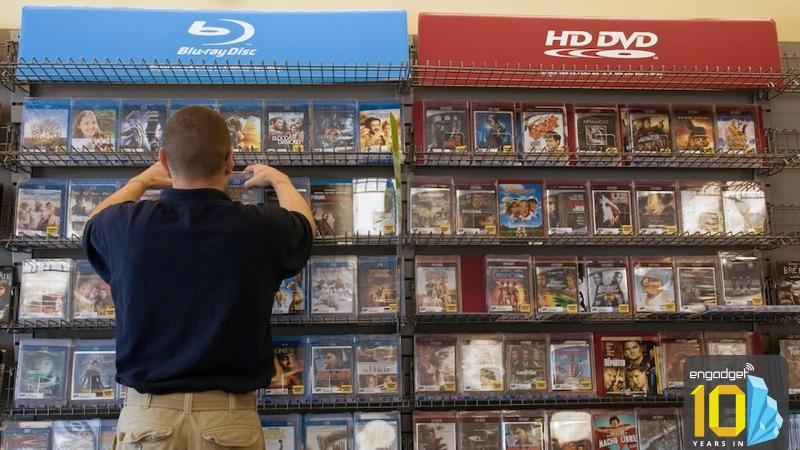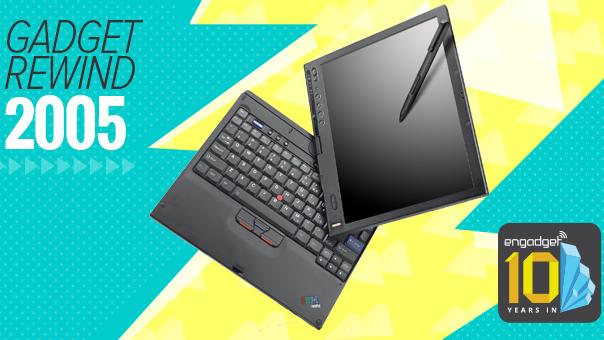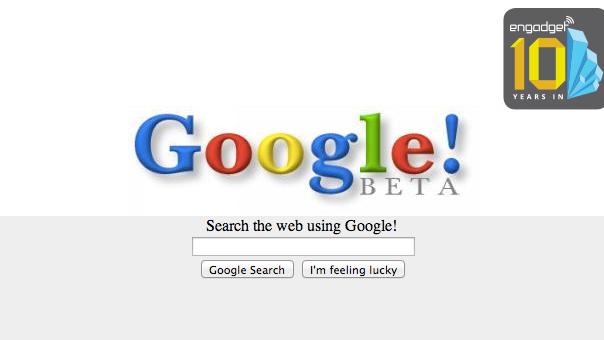10yearsin
Latest

Gadget Rewind 2008: T-Mobile G1 (HTC Dream)
In 2005, a small Palo Alto-based mobile software company called Android Inc. was quietly folded into Google's growing empire. The acquisition led to the release of the company's first-ever "Google phone" three years later: the T-Mobile G1 (or HTC Dream as it was mostly known outside of the US). Google's philosophy for the G1 centered on one-click search and a rich web experience, and leveraging T-Mobile's 3G network was essential to its success. The G1 was also the first smartphone to run the open-source Android operating system and after just six months on the market, it earned a fifth-place spot amongst top-selling smartphones in the US.

Gadget Rewind 2006: Nintendo Wii
Nintendo planned a "Revolution" for your TV. When it arrived in 2006, it was a lot more fun than the confrontational term might imply. Revolution turned out to be the code name for the company's new console, and just before E3 that year Nintendo ditched the subterfuge and unveiled its official title: Nintendo Wii. It was revolutionary, using motion-tracking remotes to get players off the couch and involved in the action. The Wii rapidly became the centerpiece at parties, stepping into the arena with classics like Pictionary and charades. The console's popularity was also a welcome turnabout for Nintendo, which had been languishing over its latest console's missteps.

Gadget Rewind 2004: iRobot Roomba Discovery
Little robot helpers found a place in our hearts and homes in 2002 when iRobot introduced the Roomba. This house-cleaning 'bot definitely made for an odd addition to the company's existing lineup of space exploration, minesweeping and tactical support devices. But beyond the novelty factor, the first Roomba model wasn't an immediate success for the company. After heading back to the drawing board, iRobot released a vastly improved model in 2004 called the Roomba Discovery. It had enhanced cleaning powers, longer battery life and was significantly smarter. The Discovery may not have been a true replacement to traditional vacuuming, but it definitely justified its cost and earned a solid customer base. It was also affordable, costing only a couple hundred dollars compared to competitor products like the 2004 Electrolux Trilobite, which shot well past the $1,000 mark.

Format Wars: Blu-ray vs. HD DVD
The format war. Over the last few decades it has played out across various forms of tech -- AC vs. DC, VHS vs. Beta -- usually with fierce battle lines drawn and millions, or even billions, of dollars at stake. Recently, none has burned so brightly as the battle of HD DVD vs. Blu-ray (read our blow-by-blow retrospective of the 2005-2007 battle here). And it brought all the classic elements: Sides were divided between titans of the industry, led by Sony pressing the Blu-ray side and Toshiba backing HD DVD, with the PS3 and Xbox 360 ready to serve as Trojan horses. As if the stakes weren't high enough already, the specter of an oncoming internet-streaming winter loomed like Game of Throne's army of White Walkers. So what really happened? Who won in the end? And, most importantly, was that victory actually worth it all?

Gadget Rewind 2007: ASUS Eee PC 4G
The ASUS Eee PC was launched in 2007 and while it had all the characteristics of a "netbook," it arrived before the term had wormed its way into popular vocabulary. This species of compact computer -- essentially miniaturized, internet-focused laptops -- took the market by storm in the late 2000's, but failed to have much staying power and ultimately faded from view. At the time, these stripped-down portables from Taiwan-based ASUS, filled a growing niche for people on the go. They offered just the essentials, while still managing to provide a surprisingly good bang-for-buck ratio. The Eee PC was aimed at users who rarely stepped beyond the bounds of basic web surfing and email, so it was easy for ASUS to trim the fat and offer a small, lightweight device. In fact, that undemanding demographic was the inspiration for its titular triple E's: "Easy to learn, Easy to work and Easy to play."

Gadget Rewind 2007: Aliph Jawbone
In the years before texting's domination of smartphones, the mobile-toting masses relied heavily on headsets and earpieces to stay connected. These people would often be seen shouting crazily into the air just so they'd be heard over environmental noise. That's about the time Aliph arrived with a solution with its first Jawbone earpiece. It sported military-tested noise cancellation and bone-conduction sound tech, as well as clean styling from designer Yves Béhar. The first wired iteration showed up in 2004, offering an alternative to the "business basics" style that was typical of mobile headsets at the time. It wouldn't be until 2007's Consumer Electronics Show, however, that Aliph would give consumers a redesigned and colorful wireless option with the release of the Bluetooth-enabled Jawbone.

From foe to friend: my journey with Linux
Nowadays, it's just a sanctuary for my father to play marathon sessions of Diablo 3. But a little over 15 years ago, the breakfast nook in my parents' kitchen more closely resembled a coliseum where man (my father) was pitted against machine. Back then, it wasn't uncommon to hear strings of profanities streaming out of the room while he sat in front of a desktop computer hunched over in defeat -- all in an attempt to run Linux. "What the... ?" (loud clacking of keys) BEEP "I don't get it..." (banging on keys) BEEP "God damn piece of shit!" (punching of keys, distinct metallic crash) "Grrr..."

Gadget Rewind 2007: Pioneer Kuro PDP-5080HD plasma
The bleeding edge for pixel-pushing displays has shifted, and 4K, aka Ultra HD, is the one to watch. Though the once-great 1080p HD specification has now become commonplace, seven years ago, it was an altogether different story. Pioneer, one of the leading manufacturers of plasma televisions at the time, chose to buck the popular trend toward pricey "full HD" sets, and instead focus on more affordably priced sets under 60 inches. But cost wasn't the only differentiator for Pioneer; it also aimed to deliver the best picture quality possible, regardless of the spec sheet. From this line of Kuro (meaning "black" in Japanese) displays arose an award-winning 50-incher called the PDP-5080HD, which sported a humble 720p resolution.

Gadget Rewind 2005: Lenovo X41 Tablet
Lenovo made headlines earlier this year when it took Motorola Mobility off of Google's hands, giving it a boost in smartphone markets outside of its usual stomping grounds. But that wasn't the first time it snatched up another company for industry leverage. In 2005, IBM gave up majority control of its PC business, allowing Beijing-based Lenovo to take over and effectively expand its reach to a global audience. The timing of the deal was a little bit off, however. One of the first products to launch under Lenovo's new ownership was the ThinkPad X41 Tablet, a laptop/tablet hybrid, which had already rolled off the assembly line and was still sporting an IBM logo.

Whatever happened to Netscape?
Netscape's story reads like a proper fairy tale: takeovers, fierce and hostile competition, split-ups, a giant payout and even a dragon! While Netscape may now only be a sweet, sweet memory to those who used it to first discover the web, the browser's monstrous impact has cemented it as one of the first and most important startups to shape the internet. Netscape's founders successfully plucked a brilliant idea from academia and pushed it onto the world's stage at a time when competition didn't exist, websites were not much more than plain-text blurbs and inline images were still revolutionary. Consider the battle that would ensue between this web pioneer and Microsoft. The "browser wars," as they came to be known, would ultimately lead to creation of Internet Explorer, Microsoft's antitrust suit and the formation of the Mozilla Project and Firefox.

Engadget Rewind 2008: BlackBerry Storm
Smartphone makers were still reeling from the arrival of Apple's touchscreen-only iPhone when 2008 rolled around. Research in Motion (RIM), a mobile manufacturer best known for its BlackBerry line and QWERTY keyboard prowess, was at the top of its game and primed to jump into this emerging form factor. That year, it launched the BlackBerry Storm smartphone -- a direct rival to Apple's handset. As RIM's premier effort in touchscreen smartphones, it offered an interesting spin on the interface with what it called SurePress. This was a touchscreen you could depress or click; an innovation RIM hoped would bridge the gap between the company's current physical keyboard-accustomed clientele and the next generation of smartphone buyers. The Storm was RIM's attempt to solve the "problems associated with typing on traditional touchscreens" and leverage its longtime experience with clickable keys. While the phone had a sleek and solid build, a vibrant 3.25-inch display and was backed by Verizon's network, that SurePress technology ended up doing more harm than good.

Gadget Rewind 2005: Xbox 360
The current-gen console wars may be tilting in Sony's favor with its PlayStation 4, but once upon a very recent time (i.e., the previous console generation), Microsoft had a big early lead. When the company released its Xbox 360 back in 2005, the console had a considerable head start on the competition, beating Sony's PlayStation 3 launch by a full year. There were, however, intrinsic pitfalls in rushing the 360 out to market so fast; hardware problems Microsoft paid for dearly.

Google Search: A visual history
"To organize the world's information and make it universally accessible and useful." That was one of the primary goals Larry Page and Sergey Brin set when they launched Google in 1998 as a privately owned search company. Since then, the Mountain View-based outfit has branched out, creating a mobile operating system, mapping service, cloud-based productivity apps, branded devices and, now, smart thermostats. All of those offshoots, however, always point back to the company's original aim: search. That baseline service is something Google's been making refinements to ever since its inception. A practice that continues to this day, with the company constantly improving upon the usability and design of its search-based offerings. This means cleaning up a UI when needed, and launching new features that serve up that much-lauded universal accessibility in short order. What may come across as a small box centered in a vast expanse of white is, as you'll see, actually something that's constantly evolved since '98.

The gadgets that changed your life
When we asked you to tell us which gadgets changed your life, our goal was to arrive at a simple list of important devices. Instead, we learned how some of the products we talk about on Engadget every day make such a profound impact on your life. Remember when Facebook bought Oculus VR a few weeks ago? The news led to heated conversations about how VR technology would lose its edge and become a vessel for "branded experiences" (or in layman's terms: fancy ads). But we've seen actual life-altering uses of the Oculus Rift as well. For example, before Roberta Firstenberg passed away (and far too young, we might add) this technology gave her an opportunity to relive her younger years and see the sun one more time.

Gadget Rewind 2006: Lego Mindstorms NXT
Lego, the popular toy brick maker, graduated from simple plastic playthings in 1998 when it released its Mindstorms Robotics Invention System (RIS). Born of a collaboration between Lego and the Massachusetts Institute of Technology (MIT), these "toys" let users build a variety of interactive humanoid, animal and vehicular robots. Although the product underwent iterative revisions over the years, it wasn't until 2006 that the company decided to introduce its true next generation of Mindstorms kits, appropriately dubbed NXT.

My First Time on the World Wide Web
The World Wide Web. It sounds like such a silly thing when you actually spell out those consecutive W's. Nowadays, we just say "the internet," but once upon a time the web was a new and exciting thing. It was a massive communications breakthrough that captivated minds both young and old with the promise of an "information superhighway," and forced us to endure achingly slow dial-up connections. Last month, the web turned 25 years old. Yes, Tim Berners-Lee's simple creation has gone on to spawn this digitally connected world we live in: the social networks, mega e-tailers and search engines we all know and depend on today. Things were simpler when the web started out, but we assure you, our early experiences were no less weird.

Gadget Rewind 2006: Sony Reader PRS-500
Sony may not have been at the forefront of the digital music revolution, but when it came to e-books and e-readers, the company was certainly a pioneer. It all started in the '90s with Sony's first chunky, flip-topped Data Discman. This two-pound, paperback-sized player came bundled with a selection of reference books on disc, each capable of storing up to 100,000 pages of digital text. When that cumbersome early e-book solution failed to gain traction, Sony went right back to the drawing board and returned in 2004 with the Japan-only LIBRIé e-reader. This particular device used an innovative E Ink display and relied on an e-book loan program -- a distribution model that proved unpopular with consumers at the time.

Which gadget changed your life?
When we ask readers like you to help us rank the top gadgets, we usually focus on the best (and sometimes the worst). Recently, you selected our Readers' Choice winners for the 2013 Engadget Awards, but in the spirit of our 10th birthday, we wanted to try something a little different. Do you have a gadget that's changed your life? Perhaps you made a leap from the LG enV VX9900 feature phone to the mystifying world of smartphones and scooped up an iPhone 3GS (like this author did in 2009). Or when you decided to move to the other side of the world and your Mom bought a Logitech QuickCam Pro 9000 to keep in touch and see your darling face over Skype.

Gadget Rewind 2005: Slingbox
A company called Sling Media burst onto the scene in 2005 with a relatively new idea: give customers the ability to access their home cable and video services while they're traveling. Its "place-shifting" concept was embodied in its first device: the Slingbox. While you're on the road, this set-top-like box served to connect you to your very own TiVo recorded shows, media PC or cable and satellite TV services, provided you had a computer with Sling Media's software and an internet connection (preferably high-speed). The original design was somewhat unique, resembling an oversized candy bar (Sling calls it an "ingot"), and it was a clear favorite of both Engadget editors and readers, earning the title of best home entertainment device for 2005. At launch, the $250 price certainly wasn't cheap -- especially for standard definition only -- and it was markedly Windows-centric, excluding Apple users until its Mac compatible software arrived around 2007.

Facebook: A visual history
Sit down. Strap on your virtual reality headset. Now you're navigating the crowd of your online friends, sparking face-to-face conversations in a virtual world peppered with branded "experiences." Gone are the days of clicking through images of your friends' far-flung vacations; now you walk the beaches of Fiji, sipping tropical drinks, watching and hearing the waves crash like you're there -- because you are.






